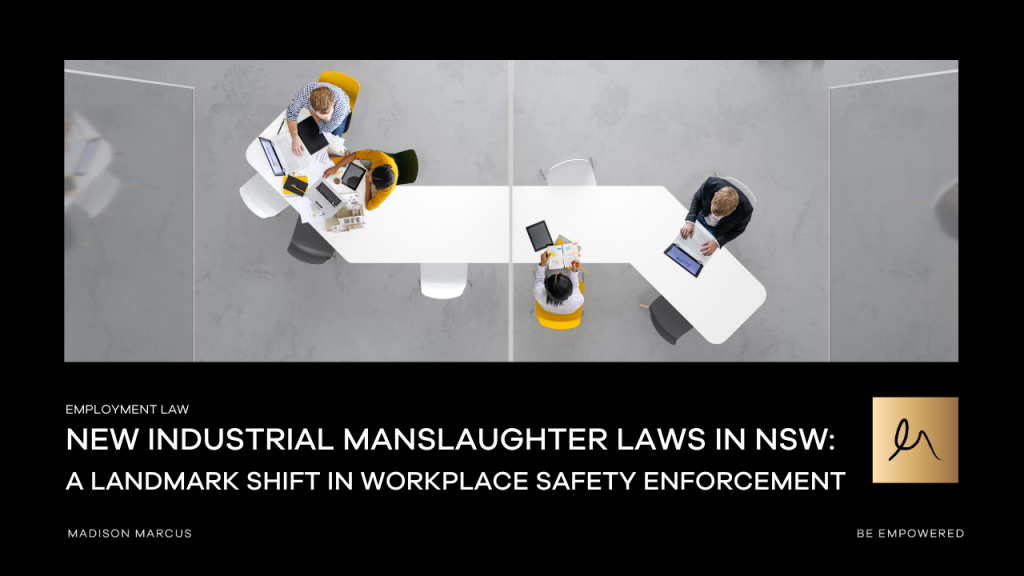Industrial Manslaughter
The New South Wales (NSW) Government has introduced this new offence of industrial manslaughter through amendments to the Work Health and Safety Act 2011. This legislative change forms part of the broader Closing Loopholes Act enacted by the federal government last year.
Industrial manslaughter carries severe penalties, including a maximum of 25 years imprisonment for individuals and fines up to $18 million for bodies corporate or the Commonwealth.
Until now, the most serious offence under the Work Health and Safety Act 2011 (NSW) is a Category 1 offence, which carries a maximum penalty of 5 years imprisonment for individuals and a $4 million fine for corporations. From 1 July 2024, penalties for Category 1 offences increase to 10 years imprisonment and $10.4 million, respectively.
Statistics reveal that there have been 4 successful prosecutions of Category 1 offences in NSW, all involving corporations, with the highest fine being $2.025 million. Since 2017, six states and territories have introduced industrial manslaughter offences with higher penalties, such as 25 years imprisonment. There have been four successful prosecutions for industrial manslaughter in these states, including one individual receiving a 5-year sentence (suspended after 18 months) and a corporation fined $3 million.
Government Introduces Industrial Manslaughter Bill to Enhance Workplace Safety
The NSW Government introduced the amending legislation by claiming the following:-
- It was fulfilling a major commitment to safeguard workers by introducing an industrial manslaughter offence through the establishment of Part 2A within the Work Health and Safety Act.
- The amendments are aimed at ensuring more effective prosecution of workplace deaths, which have rarely been prosecuted under existing manslaughter laws in the Crimes Act 1900.
- Category 1 offences, whilst they cover workplace deaths, are not specifically designed for this issue. The new industrial manslaughter offence aims to fill this gap, thereby enhancing workplace safety and serving as a deterrent.
Key Provisions of the Legislative amendments
-
Application and Elements of the Offence (Section 34C):
- The offence targets those with a health and safety duty, specifically a Person Conducting a Business or Undertaking (PCBU) or an officer of a PCBU.
- A PCBU can include a corporation, partnership, unincorporated association, self-employed person, or sole trader.
- The offence applies to individuals whose actions or decisions significantly influence workplace safety and culture.
-
Exclusions and Definitions (Section 34D):
- Volunteers are excluded from the industrial manslaughter offence but may still be subject to manslaughter charges under the Crimes Act.
- The definition of a worker is broad, covering employees, contractors, subcontractors, labour hire employees, outworkers, apprentices, trainees, students gaining work experience, volunteers, and more.
-
Scope of the Offence
- The offence applies to deaths resulting from gross negligence, defined as conduct falling significantly short of the standard of care a reasonable person would exercise and involving a risk of death or serious harm.
- Penalties include up to 25 years imprisonment for individuals and a $20 million fine for corporations.To establish the offence of industrial manslaughter, the prosecution must prove several key elements:
-
Duty of Care: The individual or corporation owed a duty of care to the deceased. This is often straightforward in the context of employment, where employers have a clear duty to ensure the health and safety of their workers.
-
Breach of Duty: There must be a breach of this duty through an act or omission that constitutes a gross deviation from a reasonable standard of care. This breach must be more than mere negligence; it must be reckless or grossly negligent.
-
Causation: The breach of duty must have caused the death of the worker. This element requires establishing a direct link between the breach and the fatality.
-
Mental Element: For individuals, there must be proof of reckless or negligent conduct. This can be inferred from the circumstances, such as a blatant disregard for safety protocols or failure to address known hazards.
4. Proceedings and Penalties (Sections 34E and 34F):
- Industrial manslaughter proceedings can be initiated at any time without a limitation period.
- Category 1 offences will be available as a statutory alternative if the court or jury is not satisfied with the industrial manslaughter charge but finds the threshold for a Category 1 offence is met.
- The bill prohibits accepting enforceable undertakings for alleged industrial manslaughter offences.
- Proceedings against individuals for industrial manslaughter must be heard before the District Court or the Supreme Court, consistent with other serious criminal offences.
-
Enhanced Investigations and Defences
The amendment emphasises prompt and thorough investigation of workplace deaths, with both regulatory authorities and the DPP expected to act swiftly. All existing defences for manslaughter under the Crimes Act and common law will apply to industrial manslaughter.
Prosecution of Offences
Industrial manslaughter and Category 1 offence proceedings against corporations will be dealt with in the Industrial Court, with the option to proceed on indictment.
SafeWork NSW and the NSW Resources Regulator will handle summary prosecutions, while the Office of the Director of Public Prosecutions (DPP) will manage indictable prosecutions through a specialised unit.
Prosecutions for industrial manslaughter on indictment are likely to be initiated in the Supreme Court of NSW.
Given the severity of the penalties, it is anticipated that prosecutions will focus on clear-cut cases where there is compelling evidence of gross negligence or recklessness. The authorities will likely target industries with higher risks of fatal accidents, such as construction, mining, and manufacturing.
Steps to Protect Against Employers and PCBUs
To mitigate the risk of being charged with industrial manslaughter, businesses should implement comprehensive safety measures and foster a culture of safety compliance.
Key steps include:
- Strengthening Safety Management Systems: Companies should review and, if necessary, overhaul their safety management systems to ensure they meet or exceed industry standards. This includes conducting regular risk assessments, implementing control measures, and ensuring continuous monitoring and improvement.
- Training and Education: Providing regular and thorough training for all employees on workplace safety is crucial. Training programs should cover hazard identification, safe work practices, emergency procedures, and the proper use of personal protective equipment (PPE).
- Leadership and Accountability: Senior management must demonstrate a strong commitment to safety. This includes leading by example, providing the necessary resources for safety initiatives, and holding all levels of staff accountable for adhering to safety protocols.
- Engaging External Auditors: Engaging third-party safety auditors can provide an unbiased assessment of the company’s safety practices and identify areas for improvement. External audits also demonstrate a proactive approach to safety, which can be beneficial in the event of an investigation.
- Documentation and Record-Keeping: Maintaining detailed records of safety procedures, training sessions, incident reports, and corrective actions taken is essential. This documentation can serve as evidence of the company’s commitment to safety and compliance with legal requirements.
- Emergency Preparedness: Developing and regularly testing emergency response plans ensures that employees are prepared to act swiftly and effectively in the event of an incident. This includes conducting mock drills and reviewing emergency procedures regularly.
- Worker Engagement and Communication: Encouraging open communication between workers and management about safety concerns and suggestions can help identify potential hazards and foster a culture of collective responsibility for safety.
- Legal Compliance: Staying informed about changes in workplace safety laws and regulations is crucial. Companies should ensure they comply with all legal requirements and seek legal advice when necessary to navigate complex regulatory landscapes.
Industry-Specific Considerations
While the general principles of workplace safety apply across all sectors, there are industry-specific considerations that businesses should take into account.
Here are some tailored recommendations for various sectors:
-
Construction:
Given the high-risk nature of construction work, it is essential to implement rigorous safety protocols, conduct regular safety audits, and ensure that all workers are adequately trained and equipped with appropriate PPE. Specific attention should be paid to high-risk activities such as working at heights, excavation, and machinery operation.
-
Healthcare:
In the healthcare sector, managing risks associated with infectious diseases, handling hazardous materials, and ensuring the safety of both staff and patients are paramount. Regular training on infection control, proper use of medical equipment, and emergency response procedures are critical.
-
Manufacturing:
Manufacturing environments often involve heavy machinery, chemicals, and complex processes. Ensuring proper machine guarding, safe handling of hazardous substances, and effective communication of safety protocols can help mitigate risks.
-
Retail and Hospitality:
In retail and hospitality, risks may include slips, trips, and falls, manual handling injuries, and exposure to potentially violent situations. Implementing ergonomic practices, providing training on conflict resolution, and maintaining clean and safe environments are important measures.
-
Logistics and Transport:
The logistics sector involves significant risks related to vehicle operation, manual handling, and load securing. Regular vehicle maintenance, driver training, and adherence to safe loading and unloading practices are crucial.
The introduction of the industrial manslaughter offence in NSW marks a significant shift in workplace safety enforcement, particularly for high-risk industries like construction. The severe penalties associated with this offence underscore the importance of robust safety management systems and a proactive approach to risk mitigation. By strengthening safety protocols, providing thorough training, fostering a culture of accountability, and maintaining meticulous records, businesses can not only protect their employees but also safeguard themselves against the serious consequences of industrial manslaughter charges.






